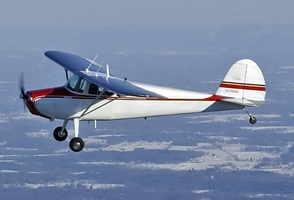Okay, just like everybody else I had to find out for myself the advantages/ disadvantages of compression verses tension steering springs. As I was getting my tail wheel endorsement I was concerned about the ground steering of my airplane, I asked my instructor who is a very experienced tail wheel person what is one to do? He said I could try compression springs which would give me more positive steering " BUT" he cautioned me the due to the 170 steering geometry and tail weight I may start bending steering arms. Me feeling neigh invulnerable went and bought a set of compression springs, installed them and noticed that yes, more responsive steering BUT wasn't keen on the amount of tourqing evident on the rudder horn. I just figured I'll be careful not to apply full rudder when not rolling, well while good in theory wasn't the case in actuality, I started to notice my steering arms bending at the end of every flying day, HUM?? Okay I know what I will do, I'll just go and order the heavy duty arm that Scott has and everything will be fine, right??
Well the new arm shows up, hey it looks BEEFY great!! so out to the airport I go,during the installation the instructor who gave me my checkout came over to visit, he sez oh your putting on the heavy duty arm, hum, yea it will help on the geometry thing with the bent up tabs but what will happen is that instead of bending it may start twisting on you.
I said " naw look how BEEFY it is" so now everything's together but to late to do any flying so I'll wait till the weekend t check it out. Sunday rolls around and it seems nice to do some flying, get to the airport to find that the rest of the world is nice but that darn west wind at Aeroflex. Well typically at Aeroflex the winds die down about late afternoon so I figure ( Don't worry I am going somewhere with this

) I'll cut the grass around my tie down. I get the community push mower roll it over to my spot, figure I'll untie the plane and just push it off to the side to make it a little easier to cut. I cut my little square of rented airport real estate, roll the mower back to the hanger (the mower gets a hanger but I cant!!) and go push the airplane back, HEY what's up with my tail wheel something's not right? wouldn't you know it just from pushing the airplane back and to the side 20 feet was enough to TWIST my HEAVY DUTY steering arms like pretzels!! Well after about ten mins of saying non Christian things the tail went up on a step ladder and got reacquainted with it's tension springs and the compression springs I placed on the fbo counter next to the doughnuts, the doughnuts are gone but the springs are still there, go figure

This is my story, and I'm sticking with it!!

